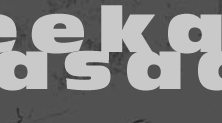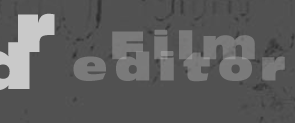My
attempt to unravel the enigma behind editing
is essentially why this page prevails. This
endeavor springs from a persistent urge to
share my experiences, specifically with
upcoming young editors. Hence it gives me
immense pleasure to delve into a topic that
will always be a part and parcel of me.
|
Editing is a world of its own
where a film could be reborn, it is at the
editing table where a film takes actual shape
and is infused with a comprehensive
dimension….
|
Every editor would have his
take on the craft, but by and large there are
certain fundamental aspects that have become
an integral part of editing.
|
Slick editing is synonymous
with pace and rhythm. Any work of editing
devoid of these two qualities will inevitably
damage the comfortable flow of a film.
|
A film's content and
treatment determine the rhythm and pace of a
film. One can arrive at the required rhythm
and pace, by the compilation of the best
possible combination of performances and
expressions. The selection of shots and their
duration on screen is crucial to create the
desired impact in the given scene. When you
string various shots together while sustaining
a certain emotional level you are invariably
setting the momentum of the entire film. The
more seamless a film appears the better it has
been edited. When a performer is doing a
fabulous job, you cannot interrupt him or her
with cuts, even though you may have the option
to do so. If an actor is fabulous in a long
uninterrupted take, the editor should not
intervene. The cardinal rule is to strike a
balance between the narrative pace and the
performances.
|
Eventually
it all boils down to a good sense of
judgement. For example, if a shot in a film
has a girl crying you can keep it on for 10,
20 or even 40 seconds, but as an editor you
should be able to gauge the film's impact on
the audience.
|
|
If one looks at the entire film
scenario and the contributions by the various
technicians involved, an editor's role is far
more important than just being associated with
the length of the film, as commonly believed. He
in fact makes for the first audience of any
film, providing the director with an objective
insight. This is possible because an editor may
not be present during the shooting of a film and
therefore he is able to adopt an unbiased
approach towards the film.
|
|
The rapport an editor shares
with his director plays a pivotal role in
determining the quality of his work. Once you
understand your director, that's half the battle
won. A director's enthusiasm about his project
is infectious and that motivates the crew to
give in their best. Ideally an editor should be
a part of the team, from the day the script is
ready, so he has time to prepare even before the
film reaches the editing table. I have been
lucky with the directors I have worked with.
They have given me ample freedom and have
seriously considered my suggestions. That is
because they believe that my thoughts are in
sync with theirs. That kind of confidence is
important between a director and an editor.
|
|
Having spoken in length about
the importance of a relationship shared between
a director and an editor, the next obvious step
would be to talk about the memorable experiences
with the directors I have worked with.
|
|
It would be appropriate, to
start of with Santosh Sivan, as my association
with him goes all the way back to the film
'Raakh' which was his first as a cinematographer
and mine as editor. Santosh is a master of
sudden ideas. More than a planned shoot, he
works by his instincts. Sparks fly when he gets
behind the camera, both as a cinematographer and
as a director.
|
|
'Terrorist' was tremendously
visual and editing the film was sheer pleasure.
Santosh's tendency to experiment brought out the
best in me too. Throughout, 'Terrorist' enticed
innovation, like the use of tight close-ups,
blank frames and still photographs as
transitions for some of the scenes. Usually,
when you see blank frames u think there is
something wrong. But we used them in such a way
that they merged with the film. For instance
when the girl realizes she is pregnant we use
blank frames and the duration of the blank
frames increased indicating the growth of the
child.
|
|
As far as 'Asoka' is concerned,
it was a tough film to edit. Being a period
film, Santosh's energy and imagination had to be
more disciplined. Yet his stamp could be felt in
every shot, like the removing of the sword,
which had three different cuts. The film's pace
had to be advanced despite the philosophical and
meditative underpinnings of the plot. To edit
the battle scenes was particularly challenging
as they were shot with six different cameras.
With whatever resources he had at his disposal,
he did a stupendous job, and the film which must
have cost about Rs. 8 crores ended up looking as
if Rs. 30 crores had been spent on it. It will
always remain a joy, being a part of his
creative madness.
|
|
From a world of madness, now I
move on into a world of silence, a world that
belongs to Shaji Karun. Shaji is basically soft
spoken by nature and puts you in ease, which
results in a conducive working atmosphere. He's
well planned and very open to suggestions, which
allows me a certain level of freedom with him. I
am glad that I got such a fantastic opportunity
to edit work of such high creative standards.
|
|
Shaji's films are a reflection
of the man himself, they are multi layered and
have a metaphysical approach. As in the case of
'Vanaprastham', his philosophical outlook and
the metaphors had to be kept firmly intact. The
use of the Kathakali art form was the film's
triumph and extremely difficult to edit
initially. We had to stick to the purity of
Kathakali; we couldn't break the rules under the
guise of cinematic license. A Kathakali exponent
sat in on the edit to see that we didn't go
astray at any point. I had to work towards
concising the Kathakali performance and weave
the story around it, which had to be done with a
lot of precision. Shaji was very particular that
they be a part of the narrative, and not just
performance for performance's sake. It was
indeed a great challenge working on this
project, which had adequate scope for me to
prove my editing skills.
|
|
From one master craftsman to
another, well I am talking about none other Mani
Rathnam himself. My association with him started
with the Tamil film 'Alaipayudhe' and ever since
we have found common ground. He expects his
editor to possess a certain level of
understanding and sensitivity. He gives the
editor considerable freedom and yet extracts
what he wants as well. He encourages
experimentation and yet ensures that we remain
within, the set parameters of the script.
|
|
As far as 'Kannathil
Muthamittal' is concerned, the editing was
patterned towards conveying the emotional
experience between a mother and her adopted
child. The story was being told essentially from
the child's perspective; the editing had to be
closer to the way a child would perceive the
conditions around her. If the camera traveled
through the war-torn areas, Mani Ratham was very
clear that this had to be seen through the
child's eyes. Instead of delving into the
horror, we had to present how a child would see
the senseless destruction. The script, of
course, was built on the child's responses, an
aspect which evolved with the film as it was
shot and edited. He was open to new ideas like
the use of ramp work, which is speeding up of
shots. Some of the shots in the song picturised
on the school children were ramped, yes, but the
speed was variegated at the editing stage.
|
|
From here I move into a
different milieu, with Prasanna Vithanage from
Sri Lanka. He introduced me to a different kind
of sensibility in film making. I was absolutely
excited about his fresh approach to cinema. The
treatments of his films are primarily simplistic
in nature and are always close to reality.
|
|
The first project we worked
together was the film 'Death on a full moon
day'. The film was stark and realistic. To make
it more so, the director did not use any
background music in the film. That was an
entirely different experience for me, because as
an editor you always have a certain assumption
about the background score when you edit, but in
this case I had to change the entire pattern of
approach, which in turn brought about a novelty
to my craft as well.
|
|
The next project with him was
'The August Sun'; posed a huge challenge due to
its demanding structure. The film had 3 stories
transpiring simultaneously, divest of a
connective chord. Therefore the challenge was to
sustain the pace of each story in a certain
tandem, so that the audiences don't disconnect
from any of them. Working with this talented
mind has undoubtedly enhanced my editing skills.
|
|
Once in a while, you feel a
breath of fresh air, wafting into your life.
This is precisely what I felt while working with
Farhan Akhtar on 'Dil Chahta Hai'. The film was
a reflection of the man himself, young and
energetic to the hilt. And hence the editing
style followed suit infusing the film with
electrifying energy. I was working with a
director who was very clued into the youth's
mindset and very clear about what he wanted to
convey. I had to get into the groove so to
speak, for the smoothness of the dramatic
sequences that he expected from me. I would sum
it up as a joyride working with this talented
young director.
|
|
Well each and every film and in
turn every director I have worked with, has
definitely made a difference to my career. And I
owe it all of them to have made me what I am.
|
|
Having edited cinema of almost
all Indian languages, I have observed that
language is not a barrier as the sentiments and
emotions of all Indian films have a common
thread running through them.
|
|
I must admit that I have a
strong inclination towards offbeat films which
are definitely more interesting and challenging.
They are more intense, with not too many
distractions like songs and fights. They
generally revolve around a central theme.
Barring a few commercial films which tried to
bridge the gap between art and commercial
cinema, all other commercial ventures are more
into fantasy.
|
|
Creativity should most
definitely take precedence over technicality,
but that doesn't mean one should be blind to the
growth of technology. I for instance started on
a moviola in which the film ran vertically and
made a lot of noise. In a short time I moved to
the Steenbeck which made no noise and was easier
to handle. Around 1995 I moved to the non-linear
avid machine. The change has definitely enhanced
the quality of my work.
|
|
At the end of the day, as in
life, each one plays by their rules, and every
editor sets his pace creating his rhythm and
this one is mine.
|



